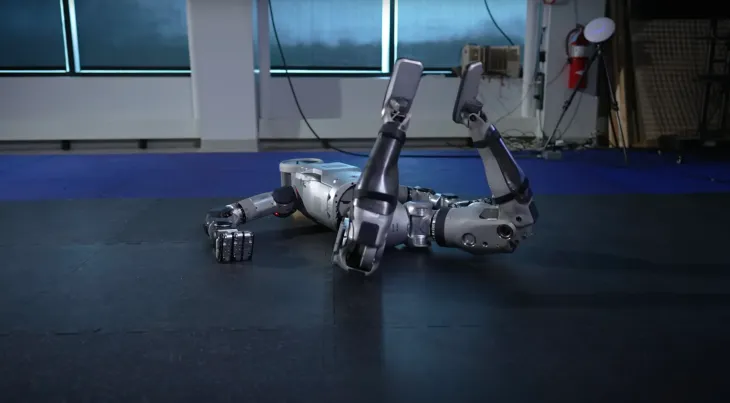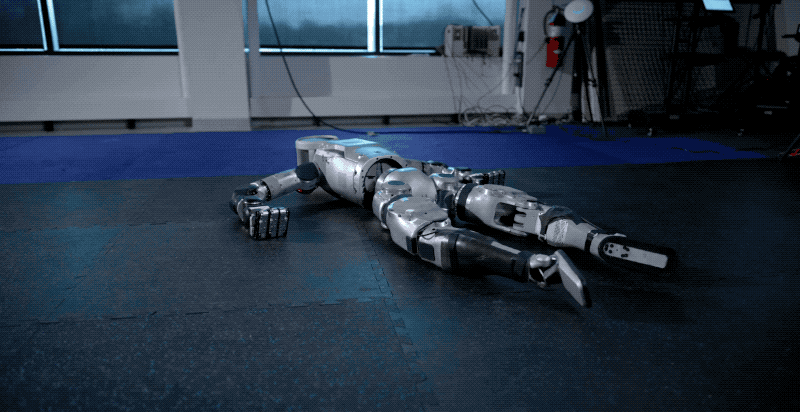Bracing Humanoid Robots for the Inevitable—Falling
Humanoid robots, like we humans, make mistakes and fall sometimes. They are not perfect yet, but like babies learning to walk, they will get better and become way more efficient than humans will ever be because they can learn and improve faster. However, it is noteworthy that it is important for these robots to fall in order to learn how to truly harness their potential.

Robots have been around for many decades. Their developments have been steady over time, and even more so in these recent times with the massive leap in innovations. The human form factor works well in a world designed for humans, and so we have been seeing many of them making headlines now, but mostly for how truly impressive they are with their potential to replace humans in many aspects of our daily lives.
Robots in general, especially factory robots, are usually heavy, and so when they fall, getting them back up can be a challenge, and that in turn can slow down processes or tasks to be completed and reduce productivity. So, it makes sense to teach these robots how to fall, get back on their feet, and continue where they left off before failure.

The Value of Falling
When we see these humanoid robots falling, it may seem rather unusual and off-setting because they are often assumed to be these perfect machines that should just turn on, do their job, and then return to hibernation. In some cases, it may even be funny to see them fall.
https://x.com/agilityrobotics/status/1644117447098929152
After having worked for about 20 hours with a 99% success rate at ProMat, Digit, a humanoid robot by Agility Robotics, fell. And it just looks like Digit goes, "I'm tired of doing this job," and just falls down, and people would be like, "I totally feel you, man." When, in reality, it really is okay and, in fact, important that these humanoid robots fall.
It is part of the learning process, just as it is for us humans. We learn to walk and balance ourselves by falling and getting back again, and just like that, robots can learn in a similar way. It allows them to learn about their environments, test their limits, and teach themselves to solve their own problems, which in this case would be picking themselves up.
When a robot falls, it can examine what went wrong and then try to adjust its movements to avoid similar mistakes later on. And this helps them improve their balance and coordination.

Designing Robots to Get Back Up
The idea is to not need human intervention for these processes to continue, and then failure happens. In this case, a robot falling and picking itself back up is very useful for maintaining productivity, especially in factories. And so some of these humanoid robot makers are designing their robots to get back on their feet from a prone position.
Just after Boston Dynamics retired their hydraulic humanoid robot Atlas, they released an electric humanoid robot with the same name, Atlas. In their demo video, they showcased the robot lying face-down on the floor, then standing up right on its own.

It may seem uncanny the way Atlas does it—standing on its own—with how very different from the way humans would do it. The idea in this case is to minimise the area of space the robot utilises to get up, as not all environments are structured to provide so much area.
Agility Robotics, on the other hand, employs the conventional human-like method to get up, with the arms pushing the body back up. What's interesting, however, is how it first tries to put itself in a familiar position to then proceed to get up.

The company has been using reinforcement learning to help fallen robots right themselves. Agility shut off Digit’s obstacle avoidance in the above video to force a fall. In the video, the robot uses its arms to mitigate the fall as much as possible. It then utilises its reinforcement learnings to return to a familiar position from which it is capable of standing again with a robotic pushup. Source
The Importance of Transparency
A lot of work goes into the demo videos of these humanoid robots we see around. Sometimes it takes a week, perhaps years, for some to achieve the perfection they show us. In those times, a lot of falling happens. And then, the value of how much effort goes into building these robots is sometimes undermined.
A robot that has fallen many times and learned how to pick itself back up is likely to fall less in the future. And so, seeing and knowing how much goes into actually building and training these robots can help people appreciate them a little more, rather than assuming that it's easier than it actually looks.
For that reason, we see many videos of Boston Dynamics' robots failing as well as their successes, which is really good as it provides more insight into their work. The same goes for Agility Robotics, with their videos all over social media.

Falling is Part of Learning
As long as these robots learn what to do when they fall, they will only get better and probably fail a whole lot less than humans do, ultimately turning into the machines we want them to be—highly effective and efficient.
I imagine these robotics companies putting their humanoid robots in environments to enable them to fall a lot more and learn. With time, high success rates will be achievable when they are fixed into workflows.
By the way, make earnings with your content on Hive via InLeo while you truly own your account. If you're new, sign up in a few minutes by clicking here! And here's a guide on navigating.
All images are screenshots
Interested in more?
Apple Vision Pro Version 2 Potential Features
Meet Figure 01: The Human-Like Robot Redefining the Future
NASA's Snake Robot to Explore Saturn's Moon for Signs of Life
The Link: Bridging Minds and Machines with Neuralink's Brain Chip
Boston Dynamics' New Era: Retiring Atlas, Welcoming All New Atlas
Posted Using InLeo Alpha

It's kinda like the robots are tired of their jobs and then they fall to the ground to rest😂😂.
Is fascinating to see that robots can stand up on their own without the help of anyone. Since they're machines it's only normal for them to stay that way until someone picks them up.
Technology is advancing so fast that it scares me that maybe in the next couple of years, humans might not even have to work or even lift a finger
It is hilarious to see them fall down to rest! 😁
In my opinion, I would like to see a future where humans don't have to lift a finger to do things. They'd only have to use their brains. It's a bit scary, but I am all the same excited for it.
Really? It would be nice to see it too I won't lie, but it's still very scary
View more
It's always mind blowing and creepy how these robots that have a human body style are designed in a more functional way than the human body itself, can you imagine if we could twist 360 our legs to stand up like that? All kind of awkward moves 😅 , definitely not easy trying not only recreate the human body but improve it for all type of conditions and situations, we fall so we can stand back up ✌️😎
You know, as the world we see now is designed for humans, it does make sense to build robots with the human form factor. The twist, however, is that the human form isn't the most effective, in real sense. So, why not upgrade the humanoids to be better than us? It's uncanny and scary, but isn't it exciting?
This is quite a major advancement in robotics. Before, there used to be a time when the possibility of humanoid robots was discussed. Now, companies are training them to stand up after they fall.
Decades ago, humanoid robots were only things we'd see in the movies. But here we are now, seeing them before us, doing work for us.
The evolution of technology intrigues me. With this feature where they can stand after falling will make robots more reliable to do day to day tasks.
You would be able to sleep and expect the robots to be able to take care of themselves. It's crazy. It's fascinating. It's exciting!
Yeap. Could you check your WhatsApp, please?
Congratulations @olujay! You received a personal badge!
Participate in the next Power Up Day and try to power-up more HIVE to get a bigger Power-Bee.
May the Hive Power be with you!
You can view your badges on your board and compare yourself to others in the Ranking
Check out our last posts: